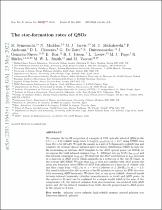| dc.contributor.author | Symeonidis, Myrto | |
| dc.contributor.author | Maddox, Natasha | |
| dc.contributor.author | Jarvis, Matthew J. | |
| dc.date.accessioned | 2022-08-03T13:09:51Z | |
| dc.date.available | 2022-08-03T13:09:51Z | |
| dc.date.issued | 2022 | |
| dc.identifier.citation | Symeonidis, M. et al. (2022). The star formation rates of QSOs. Monthly Notices of the Royal Astronomical Society, 514(3), 4450-4464. 10.1093/mnras/stac1359 | en_US |
| dc.identifier.issn | 1365-2966 | |
| dc.identifier.uri | 10.1093/mnras/stac1359 | |
| dc.identifier.uri | http://hdl.handle.net/10566/7661 | |
| dc.description.abstract | We examine the far-IR properties of a sample of 5391 optically selected QSOs in the
0.5 < z < 2.65 redshift range down to log [νLν,2500(erg/s)] > 44.7, using SPIRE data
from Herschel-ATLAS. We split the sample in a grid of 74 luminosity-redshift bins and
compute the average optical–infrared spectral energy distribution (SED) in each bin.
By normalising an intrinsic AGN template to the AGN optical power (at 5100˚A) we
decompose the total infrared emission (LIR; 8—1000µm) into an AGN (LIR,AGN) and
star-forming component (LIR,SF). We find that the AGN contribution to LIR increases
as a function of AGN power which manifests as a reduction of the ‘far-IR bump’ in
the average QSO SEDs. We note that LIR,SF does not correlate with AGN power; the
mean star formation rates (SFRs) of AGN host galaxies are a function of redshift only
and they range from ∼6 M⊙/yr at z ∼ 0 to a plateau of . 200 M⊙/yr at z ∼ 2.6. | en_US |
| dc.language.iso | en | en_US |
| dc.publisher | Royal Astronomical Society | en_US |
| dc.subject | Astrophysics | en_US |
| dc.subject | Redshift | en_US |
| dc.subject | Nuclear | en_US |
| dc.subject | AGN power | en_US |
| dc.title | The star formation rates of QSOs | en_US |
| dc.type | Article | en_US |

